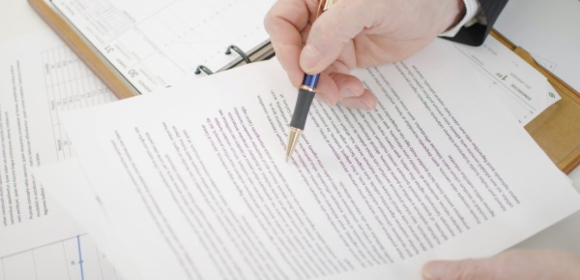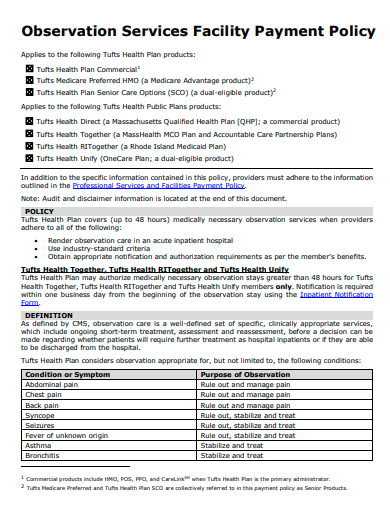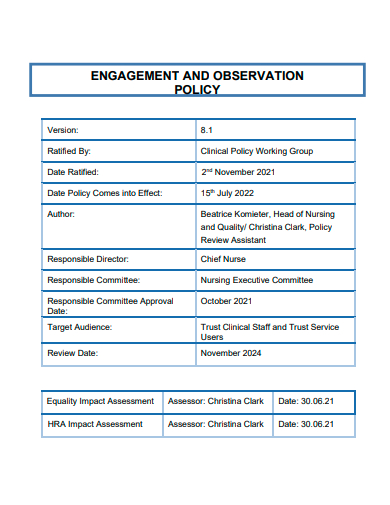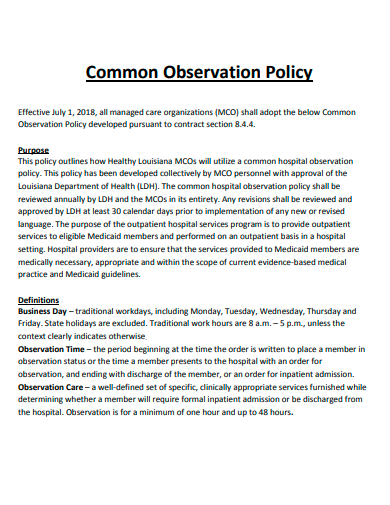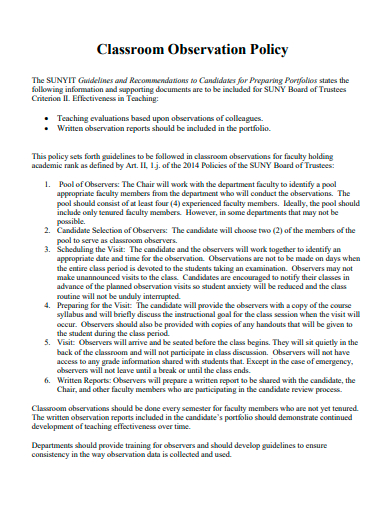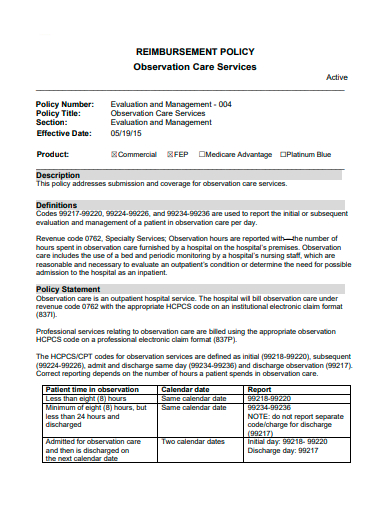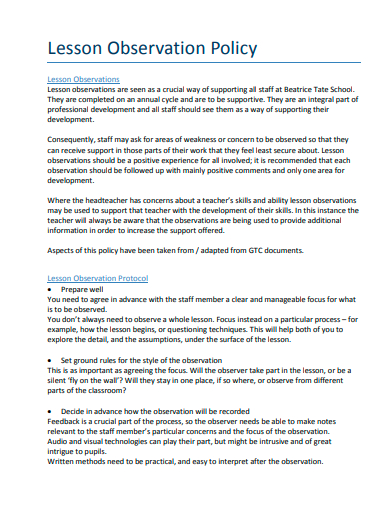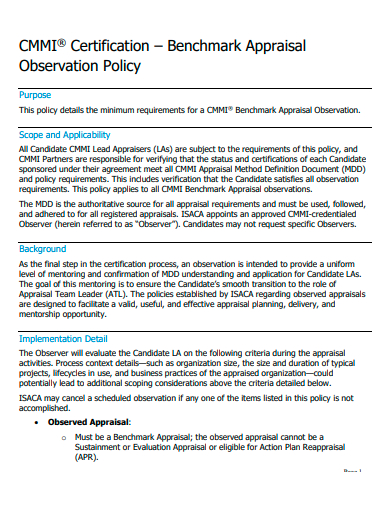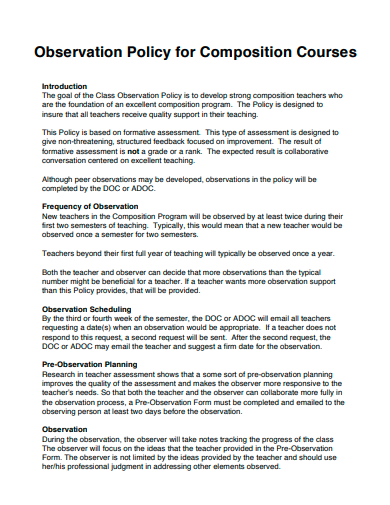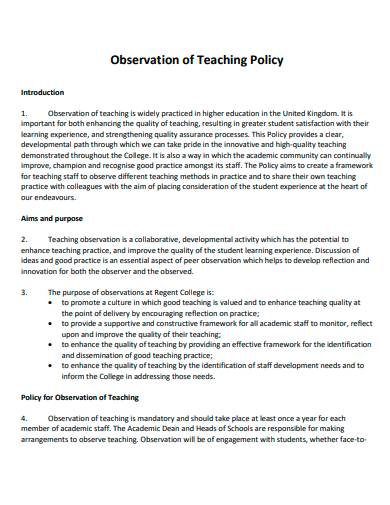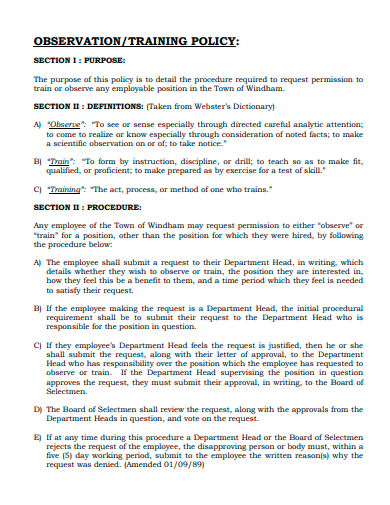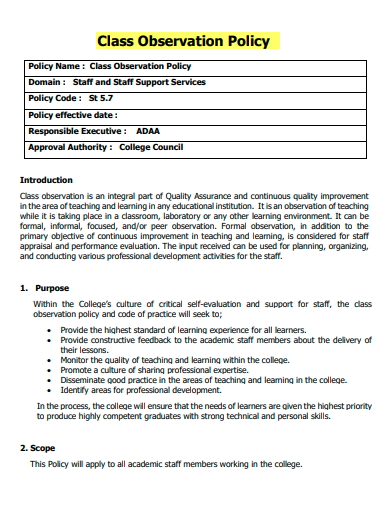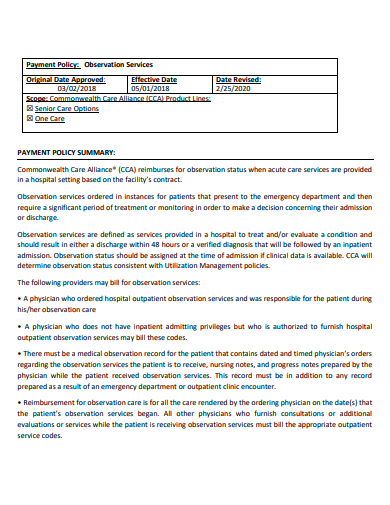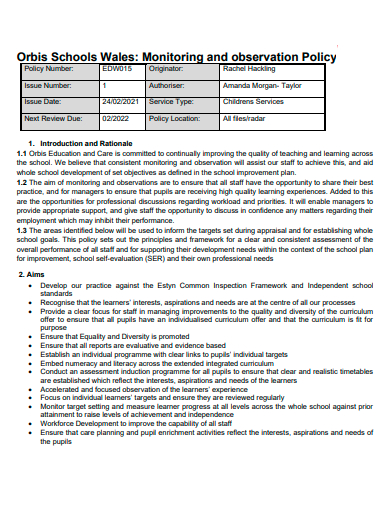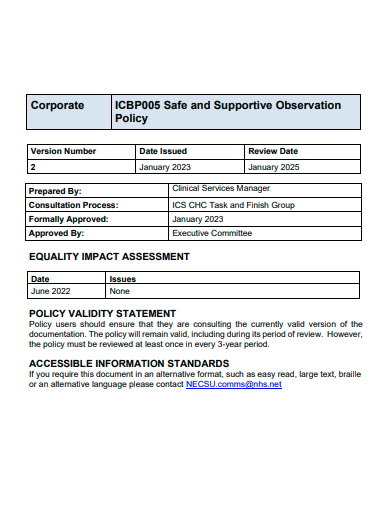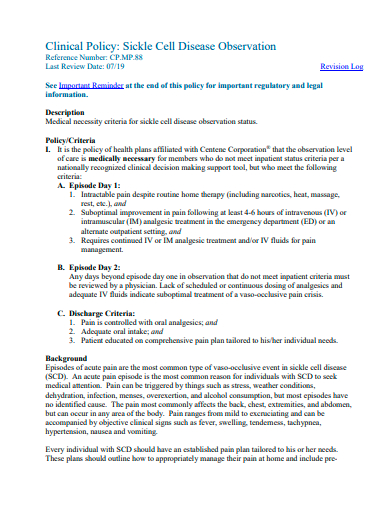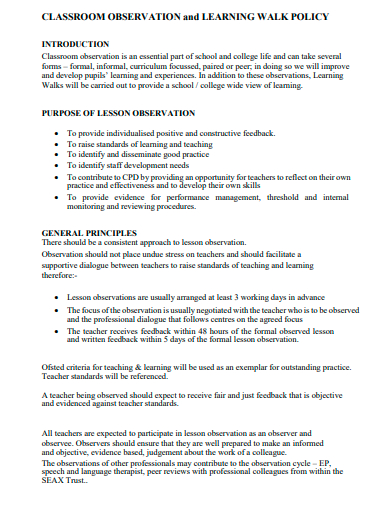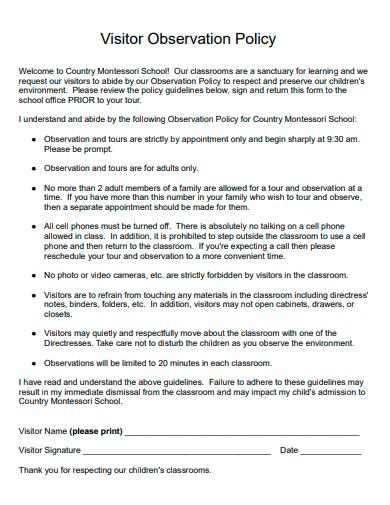Welcome to our Sample Observation Policy Template, a comprehensive guide designed to empower organizations with a structured approach to observation and risk assessment. In today’s dynamic business landscape, effective observation is key to gaining valuable insights and making informed decisions while mitigating potential risks. Our template not only simplifies the process but also ensures compliance with industry standards. From enhancing safety protocols to optimizing customer experiences, our Sample Observation Policy Template covers it all, integrating risk assessment seamlessly into your organization’s workflow. Get ready to elevate your observation game and boost your organization’s efficiency while minimizing risks.
20+ Observation Policy Samples
1. Observation Services Facility Payment Policy Template
2. Engagement and Observation Policy Template
3. Common Observation Policy Template
4. Classroom Observation Policy Template
5. Observation Care Services Reimbursement Policy Template
What is an observation guideline?
An observation guideline is a structured set of instructions and principles that serve as a framework for conducting systematic observations in various contexts, such as research, healthcare, education, and workplace settings. These guidelines are designed to ensure that observations are carried out consistently, objectively, and ethically, with the aim of collecting accurate and reliable data or information.
Observation guidelines are essential tools for researchers, professionals, and organizations that rely on observational data to make informed decisions, assess performance, identify patterns, or improve processes. Here are some key aspects of observation guidelines:
Purpose and Objectives: Observation guidelines typically begin by defining the purpose and objectives of the observation. Whether it’s to study human behavior, monitor safety protocols, or evaluate teaching methods, a clear understanding of the goals helps guide the observation process.
Scope and Focus: These guidelines outline the specific areas or aspects that should be observed. It’s important to define the scope of the observation to avoid collecting irrelevant data.
Methodology: Observation guidelines describe the methodology to be used. This includes details such as the observation techniques, tools, and instruments that will be employed. For instance, will the observation be conducted through direct participation, video recording, or structured checklists?
Ethical Considerations: Ethical considerations are crucial in observation guidelines. They define how observers should behave, ensuring that the rights and privacy of individuals being observed are respected. In healthcare, for example, patients’ consent and confidentiality are paramount.
Data Collection and Recording: The guidelines provide instructions on how data should be collected and recorded. This may include guidelines on time intervals, data categories, and any specific criteria for recording observations.
Observer Training: To maintain consistency and reliability, guidelines often recommend training for observers. This training may cover the proper use of instruments, ethical principles, and the importance of objectivity.
Data Analysis: Observation guidelines may outline the basic principles for analyzing the collected data. This includes the types of statistical or qualitative analysis that should be applied to derive meaningful insights.
Reporting and Documentation: The guidelines specify how observations should be documented and reported. This ensures that the results are communicated effectively to relevant stakeholders.
Quality Control: To ensure the accuracy and reliability of observations, guidelines often include provisions for quality control and validation of data. This may involve periodic reviews and audits.
Feedback and Improvement: Continuous improvement is a key element of observation guidelines. Feedback from observations can lead to refinements in the guidelines themselves or in the processes being observed.
Observation guidelines play a pivotal role in maintaining the credibility and validity of observational data. Whether applied in scientific research, clinical practice, or organizational management, they provide a structured and systematic approach to gathering information, making informed decisions, and driving positive change. By following these guidelines, individuals and organizations can ensure that their observations are consistent, ethical, and ultimately beneficial in achieving their goals.
6. Lesson Observation Policy Template
7. Observation Policy Example
8. Payment Observation Policy Template
9. Observation Policy for Composition Courses Template
10. Observation of Teaching Policy Template
11. Observation Training Policy Template
12. Tutor Observation Policy Template
13. Class Observation Policy Template
14. Observation Services Payment Policy Template
What are the 4 types of observation?
Observation is a fundamental research and data collection method used in various fields, from scientific research to social sciences and everyday life. There are four primary types of observation methods, each with its own characteristics and applications:
Structured Observation:
Definition: Structured observation is a systematic and predefined method of data collection where researchers carefully plan and design the observation process in advance.
Characteristics: In structured observation, researchers specify what they will observe, when they will observe it, and how they will record the data. This method often involves using standardized checklists, rating scales, or specific categories for recording observations.
Applications: Structured observation is commonly used in laboratory experiments, clinical assessments, and studies where researchers aim to gather quantitative data with a high degree of control and reliability.
Unstructured Observation:
Definition: Unstructured observation is a more flexible and open-ended approach to data collection. In this method, researchers observe subjects without a predefined plan or specific categories for recording data.
Characteristics: Researchers using unstructured observation may take field notes, record their impressions, or use narrative descriptions to capture the richness and complexity of the observed behavior or phenomena. It allows for a more holistic understanding of the subject.
Applications: Unstructured observation is often employed in ethnographic research, naturalistic settings, and exploratory studies where the goal is to gain a deep understanding of human behavior or social contexts.
Participant Observation:
Definition: Participant observation involves the researcher actively participating in the observed situation or social group while simultaneously observing and recording data.
Characteristics: Researchers become part of the environment they are studying, which allows for an insider’s perspective. They often build relationships with participants to gain trust and gather in-depth insights.
Applications: Participant observation is commonly used in anthropology, sociology, and qualitative research to study cultures, subcultures, or communities. It is valuable for understanding social dynamics and behaviors in their natural context.
Non-participant Observation:
Definition: Non-participant observation is an observational method where the researcher remains an external observer and does not actively engage or participate in the situation being studied.
Characteristics: Researchers using this method maintain objectivity and distance from the subjects, making minimal or no contact with them. Data is typically collected through direct observation or recording devices.
Applications: Non-participant observation is useful in situations where researcher involvement could bias the results or when studying behaviors or events that require detachment, such as wildlife observation, security surveillance, or clinical observations in healthcare settings.
These four types of observation methods provide researchers and professionals with a range of options for collecting data based on their research objectives, the nature of the subject being observed, and the level of control and interaction required. The choice of observation method depends on the specific goals of the study and the context in which the observation takes place. Researchers often select the method that best aligns with their research questions and the type of data they wish to collect, whether quantitative or qualitative, structured or unstructured, participant-involved or non-participant.
15. Monitoring and observation Policy Template
16. Safe and Supportive Observation Policy Template
17. Disease Observation Clinical Policy Template
18. Classroom Observation and Learning Walk Policy Template
19. Visitor Observation Policy Template
20. Patient Observation Policy Template
21. Observation Policy in DOC
How to write an Observation Policy?
Writing an Observation Policy involves careful planning, clear guidelines, and a commitment to ethical and systematic observation practices. Whether you’re creating an observation policy for a research study, a healthcare facility, an educational institution, or an organization, here are the key steps to help you develop an effective policy:
Define the Purpose and Scope:
Begin by clearly stating the purpose of the observation policy. What is the main goal of conducting observations? What areas or situations will the policy cover? Define the scope to avoid ambiguity.
Identify Stakeholders:
Determine who will be involved in the observation process and who the policy will apply to. This may include researchers, employees, students, patients, or other relevant parties.
Legal and Ethical Considerations:
Ensure that your policy adheres to all applicable laws, regulations, and ethical guidelines. Consider issues like informed consent, privacy, confidentiality, and data protection.
Methodology and Procedures:
Describe the specific observation methodologies and procedures that will be used. Explain how observations will be conducted, recorded, and analyzed. Provide details on tools or instruments to be used, if applicable.
Training and Qualifications:
Specify the qualifications and training requirements for individuals who will conduct observations. This ensures that observers are competent and aware of ethical considerations.
Data Collection and Recording:
Outline how data will be collected and recorded. Include information on data categories, variables of interest, and the format for documenting observations.
Quality Control and Validation:
Detail the measures in place to ensure the accuracy and reliability of observations. This may involve periodic reviews, inter-rater reliability checks, or calibration sessions.
Reporting and Documentation:
Explain how observations should be documented and reported. Include guidelines for creating observation reports, sharing findings, and maintaining records.
Privacy and Confidentiality:
Address how privacy and confidentiality will be maintained during observations. Specify any measures to protect sensitive information.
Informed Consent:
If applicable, provide guidelines on obtaining informed consent from individuals being observed. Explain the purpose of the observation, the expected duration, and any potential risks or benefits.
Communication and Feedback:
Describe how communication will occur between observers, stakeholders, and participants, if relevant. Encourage feedback and reporting of any ethical concerns or issues that arise during observations.
Continuous Improvement:
Emphasize the importance of continuous improvement in observation practices. Encourage stakeholders to review and update the policy as needed to reflect evolving best practices and ethical standards.
Compliance and Enforcement:
Specify the consequences of non-compliance with the observation policy. This may include disciplinary actions or other measures to ensure adherence.
Review and Approval:
Before finalizing the policy, ensure it undergoes a thorough review by relevant experts, legal advisors, and stakeholders. Once approved, disseminate the policy to all affected parties.
Training and Awareness:
Provide training and awareness programs to educate individuals about the policy. Make sure everyone involved understands their roles and responsibilities.
Monitoring and Evaluation:
Regularly monitor and evaluate the implementation of the observation policy. Collect feedback from stakeholders to identify areas for improvement.
Creating a well-defined observation policy is crucial for maintaining the integrity of your observations, protecting the rights and privacy of individuals involved, and ensuring that the data collected is reliable and ethical. Adapt the policy to suit your specific context and regularly revisit it to keep it up-to-date with changing practices and regulations.
Related Posts
FREE 10+ Suspension And Expulsion Policy Samples in MS Word | PDF
FREE 10+ Student Travel Policy Samples in MS Word | Google Docs | Pages | MS Outlook | PDF
FREE 10+ Uniform Complaint Policy and Procedure Samples in PDF
FREE 10+ Bullying Policy Samples in MS Word | PDF
FREE 10+ Fiscal Control Policy Samples & Templates in MS Word | PDF
FREE 10+ Cooperative Policy Samples & Templates in MS Word | PDF
FREE 10+ Disenrollment Policy Samples in MS Word | PDF
FREE 10+ Donation Policy Samples & Templates in MS Word | PDF
FREE 10+ Homework Policy Samples & Templates in MS Word | Pages | PDF
FREE 10+ IT and Software Policy Samples in PDF | MS Word | Pages | Google Docs
FREE 50+ Policy Samples in PDF | MS Word
FREE 50+ Membership Policy Samples in PDF
FREE 10+ Shipping Policy Samples in PDF
FREE 10+ Expense Policy Samples in Word | Google Docs | Pages | PDF
FREE 10+ Website Policy Samples in PDF | MS Word | Pages | Google Docs | Outlook
